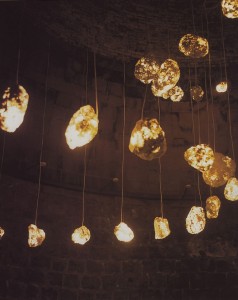PLANETARIO INCANDESCENTE
«Las tradiciones dicen que, así como hay «aguas superiores», hay fuego superiores. Las estrellas son su manifestación inalcanzable: los aerolitos y meteoritos, sus mensajeros, y por ello asimilados a veces con los ángeles y otras jerarquías celestes». Quien habla es el inagotable Diccionario de símbolos de Juan-Eduardo Cirlot.
Gabriel Díaz, por su parte, recoge la denominación de una de las categorías angélicas, los Tronos, como «los de las brasas ardientes». Quizás también quería hacer visual las formas del fuego celeste, como Leopoldo Lugones o Borges, cuando concibió Coros, presentada en ARCO 2000 en el stand de El Mundo, o cuando ha ido calibrando posibilidades diferentes de una adaptación de esta pieza al espacio del Horno de la Ciudadela de Pamplona.

En esta exposición, Coros está formado por tres círculos de piedras situados, uno de ellos a la altura de los ojos del espectador, otro que parte de su altura y se eleva hacia la cúpula y un tercero casi en el suelo, junto a los pies. Cada piedra de albastro tiene en su interior una fuente de luz amarillenta, flotando en el espacio oscuro del Horno. Como una enorme lámpara que ocupa el espacio, un planetario subterráneo, o una hilera de solemnes bienaventurados, arcángeles, serafines,potestades y otras categorías, iluminando como «brasas ardientes» la faz del supremo creador.
Sin embargo, la idea de Planetario se desvanece al entrar en contacto con Coros, al penetrar en ese espacio oscuro e iluminado a la vez, sugerente y atemorizador, que invade al espectador, involucrándose en una percepción activa, haciéndole sentir parte de un espacio sin límite, cosmonauta accidental.
«Traditions say that just as there are «higher waters», there is higher fire.The stars are its unreachable manifestation, aérólites and metéorites;its messengers, and so at times compared to angels and other celestial hierarchies». The words come from the inexhaustible Dictionary of Symbols of Juan-Eduardo Cirlot.
Gabriel Díaz takes up the denomination of one of the angelic categories, the Thones, as «those of the burning embers». Perhaps he also wished to give visual expression to the forms of heavenly fire, like Leopoldo Luones or Borges, whwn he conceived Coros, first shown of ARCO 2000 in the El Mundo stand, or when he weighed up different possibilities for adapting this piece to the spsce of Pamplona’s Horno de la Ciudadela.
In this exibition, Coros is made up of three circles of 23 stones located one at the height of the spectator’s eyes, another starting from head level and extendingup to the dome, and the third almost on the floor, next to the feet. Each alabaster stone contains a source of yellowish light, floating in the dark space of the Horno. Like an enormous lamp which fills the space, a subterranean planet, or a string of solemn anchangels, seraphim, powers and other ranks, iluminating like «burning embers» the countenance of the supreme creator.
However, the idea of Planetarium fades on contact with Coros, on entering the simultaneously dark and illuminated space, suggestive and terrifying, which invades the beholder, involving him/her in an active perception, making each one feel part of a limitless space, an accidental cosmonaut.
Francisco Javier San Martín, fragmento del catálogo «Tres Montañas».